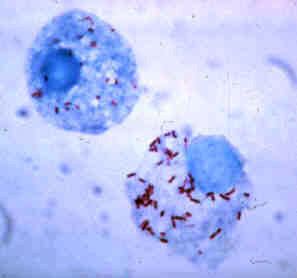Family Rickettsiaceae Higher classification Rickettsiaceae Rank Genus | Subclass Rickettsidae Scientific name Rickettsia Phylum Proteobacteria Order Rickettsiales | |
 | ||
Lower classifications Rickettsia rickettsii, Rickettsia prowazekii, Rickettsia conorii, Rickettsia typhi, Rickettsia felis, Rickettsia honei | ||
Rickettsia
Rickettsia is a genus of nonmotile, gram-negative, nonspore-forming, highly pleomorphic bacteria that can be present as cocci (0.1 μm in diameter), rods (1–4 μm long), or thread-like (10 μm long). The term rickettsia, named after Howard Taylor Ricketts, is often used interchangeably for any member of the Rickettsiales. Being obligate intracellular parasites, the Rickettsia survival depends on entry, growth, and replication within the cytoplasm of eukaryotic host cells (typically endothelial cells). Rickettsia cannot live in artificial nutrient environments and is grown either in tissue or embryo cultures; typically, chicken embryos are used: a method developed by Ernest William Goodpasture and his colleagues at Vanderbilt University in the early 1930s.
Contents
- Rickettsia
- Classification
- Spotted fever group
- Typhus group
- Scrub typhus group
- Flora and fauna pathogenesis
- Genomics
- Naming
- References
Rickettsia species are transmitted by numerous types of arthropod, including chigger, ticks, fleas, and lice, and are associated with both human and plant disease. Most notably, Rickettsia species are the pathogen responsible for: typhus, rickettsialpox, Boutonneuse fever, African tick bite fever, Rocky Mountain spotted fever, Flinders Island spotted fever and Queensland tick typhus (Australian tick typhus). Despite the similar name, Rickettsia bacteria do not cause rickets, which is a result of vitamin D deficiency. The majority of Rickettsia bacteria are susceptible to antibiotics of the tetracycline group.
Rickettsia
Classification
The classification of Rickettsia into three groups (spotted fever, typhus, and scrub typhus) was initially based on serology. This grouping has since been confirmed by DNA sequencing. All three of these contain human pathogens. The scrub typhus group has been reclassified as a related new genus – Orientia – but many medical textbooks still list this group under the rickettsial diseases.
Rickettsia are more widespread than previously believed and are known to be associated with arthropods, leeches, and protists. Divisions have also been identified in the spotted fever group and this group likely should be divided into two clades. Arthropod-inhabiting rickettsiae are generally associated with reproductive manipulation (such as parthenogenesis) to persist in host lineage
In March 2010, Swedish researchers reported a case of bacterial meningitis in a woman caused by Rickettsia helvetica previously thought to be harmless.
Spotted fever group
Typhus group
Scrub typhus group
Flora and fauna pathogenesis
Plant diseases have been associated with these Rickettsia-like organisms (RLOs):
Infection occurs in nonhuman mammals; for example, species of Rickettsia have been found to afflict the South American guanaco, Lama guanacoe.
Genomics
Certain segments of rickettsial genomes resemble those of mitochondria. The deciphered genome of R. prowazekii is 1,111,523 bp long and contains 834 genes. Unlike free-living bacteria, it contains no genes for anaerobic glycolysis or genes involved in the biosynthesis and regulation of amino acids and nucleosides. In this regard, it is similar to mitochondrial genomes; in both cases, nuclear (host) resources are used.
ATP production in Rickettsia is the same as that in mitochondria. In fact, of all the microbes known, the Rickettsia is probably the closest relative (in a phylogenetic sense) to the mitochondria. Unlike the latter, the genome of R. prowazekii, however, contains a complete set of genes encoding for the tricarboxylic acid cycle and the respiratory chain complex. Still, the genomes of the Rickettsia, as well as the mitochondria, are frequently said to be "small, highly derived products of several types of reductive evolution".
The recent discovery of another parallel between Rickettsia and viruses may become a basis for fighting HIV infection. Human immune response to the scrub typhus pathogen, Orientia tsutsugamushi, appears to provide a beneficial effect against HIV infection progress, negatively influencing the virus replication process. A probable reason for this actively studied phenomenon is a certain degree of homology between the rickettsiae and the virus – namely, common epitope(s) due to common genome fragment(s) in both pathogens. Surprisingly, the other infection reported to be likely to provide the same effect (decrease in viral load) is the virus-caused illness dengue fever.
Comparative analysis of genomic sequences have also identified five conserved signature indels in important proteins which are uniquely found in members of the genus Rickettsia. These indels consist of a four-amino-acid insertion in transcription repair coupling factor Mfd, a 10-amino-acid insertion in ribosomal protein L19, a one-amino-acid insertion in FtsZ, a one-amino-acid insertion in major sigma factor 70, and a one-amino-acid deletion in exonuclease VII. These indels are all characteristic of the genus and serve as molecular markers for Rickettsia.
Naming
The genus Rickettsia is named after Howard Taylor Ricketts (1871–1910), who studied Rocky Mountain spotted fever in the Bitterroot Valley of Montana, and eventually died of typhus after studying that disease in Mexico City.
